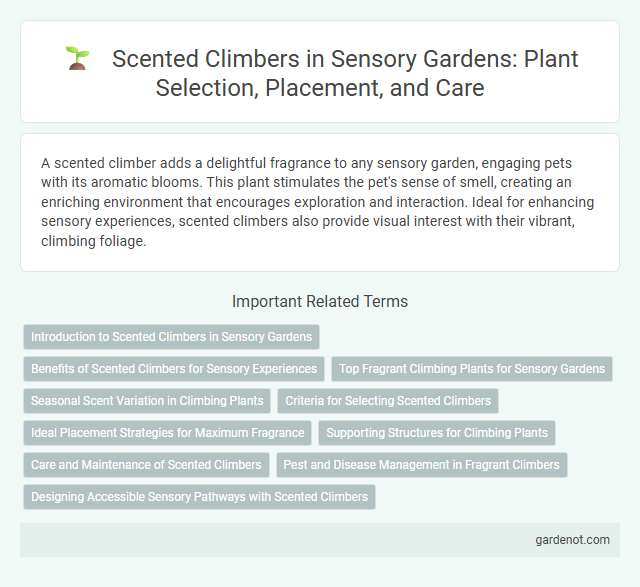A scented climber adds a delightful fragrance to any sensory garden, engaging pets with its aromatic blooms. This plant stimulates the pet's sense of smell, creating an enriching environment that encourages exploration and interaction. Ideal for enhancing sensory experiences, scented climbers also provide visual interest with their vibrant, climbing foliage.
Introduction to Scented Climbers in Sensory Gardens
Scented climbers like jasmine, honeysuckle, and sweet peas enhance sensory gardens by providing rich, aromatic experiences that engage the olfactory senses. These plants not only add vertical interest and vibrant blooms but also attract pollinators such as bees and butterflies, promoting biodiversity. Integrating scented climbers creates a multi-sensory environment that supports relaxation and therapeutic benefits in garden settings.
Benefits of Scented Climbers for Sensory Experiences
Scented climbers enhance sensory gardens by releasing fragrant aromas that stimulate the olfactory senses and create a calming atmosphere. Their tactile leaves and vibrant flowers engage touch and vision, offering a multi-sensory experience for all ages. Incorporating these climbers supports mental well-being and sensory development through natural sensory stimulation.
Top Fragrant Climbing Plants for Sensory Gardens
Jasmine is a top fragrant climbing plant ideal for sensory gardens, known for its sweet, heady aroma that enhances outdoor spaces. Honeysuckle offers a rich, fruity scent attracting pollinators and stimulating sensory experiences. Wisteria provides a powerful, floral fragrance and cascading blooms, creating an immersive olfactory garden feature.
Seasonal Scent Variation in Climbing Plants
Scented climbers such as jasmine and honeysuckle exhibit notable seasonal scent variation, releasing stronger fragrances during warmer months to attract pollinators. These climbing plants adjust their volatile organic compound emissions in response to temperature and humidity changes, enhancing sensory garden experiences throughout spring and summer. Incorporating a variety of scented climbers ensures a dynamic olfactory environment as the intensity and type of fragrance evolve with each season.
Criteria for Selecting Scented Climbers
Scented climbers for sensory gardens should be selected based on their fragrance intensity, bloom frequency, and growth habit to ensure continuous sensory stimulation and easy maintenance. Plants like jasmine, honeysuckle, and climbing roses are ideal due to their strong, pleasant scents and adaptability to various climates. Prioritizing non-invasive species with thriving growth in local soil and light conditions enhances both the garden's sensory impact and ecological balance.
Ideal Placement Strategies for Maximum Fragrance
Scented climbers thrive when planted near outdoor seating areas, entryways, or garden walkways where their fragrance can be fully appreciated. Positioning these climbers against south- or west-facing walls maximizes sunlight exposure, enhancing bloom production and scent intensity. Incorporating trellises or pergolas supports healthy growth while elevating the fragrant blooms to nose-level for optimal sensory impact.
Supporting Structures for Climbing Plants
Supporting structures for scented climbers such as jasmine, honeysuckle, and clematis are essential in sensory gardens to enhance growth and maximize fragrance exposure. Durable trellises, arches, and pergolas made from weather-resistant materials provide stability and encourage vertical growth, allowing the plants to release their aromatic scents effectively at eye level or higher. Properly designed supports also facilitate air circulation and sunlight penetration, promoting healthy blooms and intensifying sensory experiences.
Care and Maintenance of Scented Climbers
Scented climbers thrive with well-drained soil and regular watering to keep the roots moist but not waterlogged. Pruning after flowering encourages vigorous growth and maintains plant shape while preventing overcrowding and disease. Applying a balanced fertilizer in early spring supports healthy blooms and vibrant fragrance throughout the growing season.
Pest and Disease Management in Fragrant Climbers
Fragrant climbers like jasmine and honeysuckle require vigilant pest and disease management to maintain their aromatic appeal. Common pests such as aphids and spider mites can be controlled through regular inspection and natural predators like ladybugs, while fungal diseases including powdery mildew necessitate proper air circulation and fungicidal treatments. Consistent pruning and soil health monitoring also help prevent infestations and promote vigorous growth in scented climbers within sensory gardens.
Designing Accessible Sensory Pathways with Scented Climbers
Incorporating scented climbers such as Jasmine, Honeysuckle, and Sweet Pea along accessible sensory pathways enhances engagement for all visitors by providing aromatic stimuli at various heights. Designing these pathways with tactile guide surfaces and wheelchair-friendly widths ensures that individuals with mobility challenges can experience the rich fragrances safely and comfortably. Strategic placement near seating areas and interactive elements maximizes sensory interaction, making the garden an inclusive environment that stimulates smell and touch senses.
Scented climber Infographic

 gardenot.com
gardenot.com